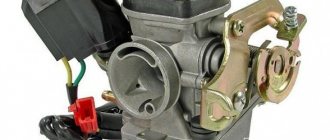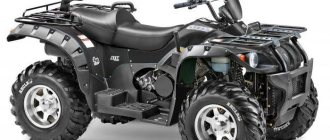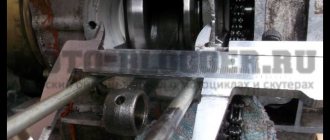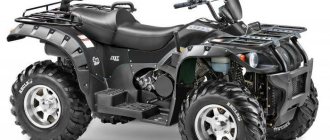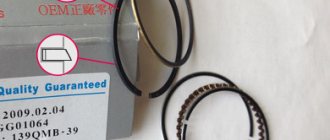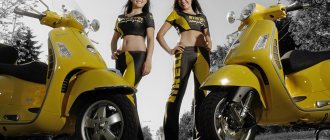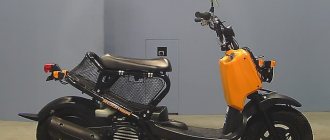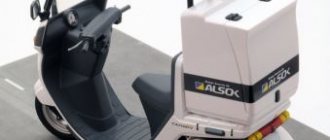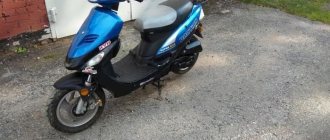Advantages of a scooter in summer Where does a scooter start or how to choose? How to choose a scooter at a bakery Choosing a used scooter Is it worth buying a new Chinese scooter?
Today, Chinese scooters in Russia have literally occupied all motor markets (like, in general, any other Chinese product in any other market).
The price of Chinese scooters ranges from 20,000 to 45,000 rubles. And it is not surprising that many of our compatriots have already tried the taste of Chinese freebies - many Chinese scooters failed on the second day of operation. But despite this, in each new season we expect an even greater influx of Chinese equipment. The main motive for this is that China produces not only bad, but also quite high-quality goods. And of course it's true. But with regard to the supply of Chinese scooters to Russia, this principle does not work well - more and more low-grade, self-falling Chinese scooters . It's hard to imagine that a cheap Chinese scooter will ever be able to compete with a Japanese scooter.
It often happens that a Chinese scooter is sold under the signature “Made in Taiwan,” or Malaysia, Indonesia, etc. But usually, if the cost of a scooter is not more than $1500, then it’s just a scam. For some reason, the scooter seller hopes that the name of Malaysia will ignite in the buyer a greater desire to purchase a scooter than China. Although, for example, Taiwanese scooters are slightly better in quality than Chinese scooters, it is rare to find them, for example, in Moscow. The exception will probably be the Korean Daelim, which combines good quality and relatively low cost - about $2000.
And yet, if there is supply, then there is demand. In addition, you cannot “bury” all Chinese scooters in one fell swoop - in fact, there are Chinese manufacturers of high-quality scooters. You just need to figure it out.
What awaits a scooterist who buys a Chinese scooter? This article describes the process of testing the device - a scooter just received from China; Let's start it, drive it, then break it down into small details, analyzing the quality of assembly and workmanship.
This article became possible thanks to one of the companies that asked to test a scooter from the Chinese brand Honling and wanted to remain anonymous and, thanks to the Scootershop company, which kindly agreed to provide the premises of one of its service centers with all the necessary equipment, and participated in the analysis.
The device being tested is a 50cc, 4-stroke Honling scooter (HL50Q7-6) . Power – 2.4 hp/7.5 kW Cooling: air. Dimensions: 1705 x 675 x 1050 mm; Base: 1170 mm. The front brake is disc, the rear is drum. Weight: 110 kg. Suspension: front – telescope, rear – pendulum. Transmission – variator. Ignition – electric, kick starter. Price in Moscow: $990 US.
Assembly and launch of a Chinese scooter
a Chinese scooter just delivered from the manufacturer , fully packaged, partially disassembled.
The packaging is clever - the corners of the wooden frame are secured with metal corners, and the fastening wire is covered with plastic so as not to scratch the plastic of the scooter. Let's take a look at the packaging - I generally like the scooter right away. The good appearance and large size are captivating. Large double seat, the set includes a large trunk (removable trunk). Although this delight dissolves as we examine the Chinese scooter more thoroughly. First things first, however.
Although the seat is large, for two people, its design does not allow one person to sit in the middle of the seat - it is made of a “step”. The case seems to be reliable, but this is only at first glance, like many things in this scooter. The trunk is made of thin aluminum, the nominal weight of luggage is 3 kg. But it is clear that even if the norm is slightly exceeded, it can easily break at the seams. In addition, one fastener is slightly bent. There is a rug under the driver's feet - an extremely impractical thing, considering that it is made of ordinary carpet.
The plastic of the scooter is, at first impression, quite bad. However, only according to the first - according to the second, it is fraught with a bunch of minor defects. These are mainly fastening elements. And the assembly of Chinese plastic is not very neat.
We place the front wheel without any obstacles. The wheel mount on this scooter is of very good quality. The speedometer drive seal is missing. The fork has corrugations instead of anthers (in principle, this is the same thing, only the corrugation breaks faster). The seals are fine.
The design of the front fork cross member is not very good. The mounting points for the fork legs are made at an angle of 45 degrees. With such fastening, even with a slight impact (curb, hole), there is a considerable risk of damage to the fork.
The tires are not bad at all, not over-dried, and of good quality.
As for the electrical connectors, it is advisable to check them all, because they were assembled, it must be said, carelessly. It’s better to check right away - otherwise a problem may arise later, albeit a small one, simply from a disconnected terminal. It is clear that it is impossible to do without the most thorough pre-sale preparation of the scooter. Having tightened and checked all the connections, we got a pretty decent picture.
All fasteners also need to be tightened.
When assembled, this scooter is very reminiscent of the Honda Spacy 125, model 94. Just as big. 50 cubes obviously won’t be enough for him.
In addition to the necessary fasteners, the underseat trunk also contained a set of tools. But the quality of these tools leaves much to be desired - you can immediately buy something better instead.
There's a whole story about the gas tank. Its lid did not open; it was blocked by a hole. And when it was finally possible to remove it and it was possible to fill it with gasoline, there was another surprise - due to the design of the filler hole of the Chinese scooter , gasoline splashed out like a fountain. That is, there will be problems at gas stations - you need to pour fuel in a thin stream. Although I would recommend not refueling your scooter directly at a gas station, but doing it in your garage using a special watering can with a filter - today’s gas at gas stations is not so great, you can even grab some garbage. It is clear, of course, that there is a fuel filter for this, but still.
The engine oil of the Chinese scooter is available in sufficient quantities. Also lubricant in the necessary places. And in some places, in abundance. This is a good sign.
A serious omission - the ignition coil (terminals) is located in a completely unprotected place - expect trouble.
The switch looks like a similar one from the Honda Dio ZX; most likely, they are interchangeable, which is also a big plus.
The battery supplied with the scooter is quite powerful, but the wire terminals are weak.
The preparatory and assembly work is completed, the scooter is ready, you can start it. When starting with the electric starter there is a terrible sound, the scooter will not start. The second time I tried, I couldn't start the scooter either. The scooter was started only on the tenth attempt, and then only after using ether. The reason was in the idle jet hole, as well as in the jet itself, which were clogged with small aluminum shavings. After cleaning the carburetor, the scooter engine spun at half a turn.
After eliminating the malfunction, the sound of the scooter's engine changed pleasantly, after all, four strokes. Having adjusted the carburetor, we notice that the instability of the scooter engine has also disappeared.
There is no opportunity to ride properly yet - it’s winter, but for those meters that we drove, the Chinese scooter demonstrated good traction. Usually Chinese 4-stroke engines turn out to be weaker. You might even think that the scooter has more horses than the declared 2.4 horses (although, for comparison, the 4-stroke Honda Dio has up to 6.5 hp).
The ghost of cheapness: why Chinese motorcycles are dangerous
When you really want a motorcycle, but don’t have the money for a quality device, many are ready to turn a blind eye to any warnings and buy a “Chinese” one. We'll tell you how such a purchase can turn out
Natalya Umnova
The Chinese auto industry has certainly progressed over the past couple of decades, and now some companies are able to produce a product worthy of competition with, for example, Korean cars. And yet, until now, most of even the most popular Chinese cars “delight” their owners with regular, more or less serious breakdowns. But maybe the Chinese are doing better with motorcycles? After all, two-wheeled vehicles are in great demand both in China itself and in other Asian countries, and are the main means of transportation for the majority of the population of India, China, Vietnam, Indonesia and other countries in the region.
Traditionally, Chinese manufacturers specialize in small-capacity motorcycles. These are motorcycles and scooters with an engine capacity of up to 400 cm3, and the bulk fits into 50-150-250 “cubes”. There are, however, several companies that produce equipment that is more similar to motorcycles in our understanding, with a 500+ cc engine, but these are usually products of former European factories bought by Chinese investors, for example, Benelli or Saggita. We will not talk about them, but will focus specifically on small-capacity budget equipment.
Everything here is like the big ones: there are scooters, scooterettes, maxi-scooters, classic motorcycles, pit bikes, enduro bikes and even sportbikes. And the number of companies producing two-wheeled vehicles and brands of this equipment is incalculable.
Who is there?
Chinese companies, both automobile and motorcycle, rarely come up with their own. And why reinvent the wheel if everything has already been invented before? It's easier to copy and change a little. And sometimes you can do without this slyness.
In terms of appearance, motorcycles don’t need to be copied too much; fortunately, casting a new plastic body kit is easier than casting a car body. But the engines and frames are worth it. The vast majority of engines installed on Chinese motorcycles sold in Russia (and in other countries) are copies of the 1958 Honda Super Cub engine (!) and its later modifications. Modern Chinese engines, based on the Honda “donor”, have a volume of 50-120 cm3.
Engines with a volume of 140-180 “cubes” are the same Cub, but with some of the “filling” from engines of the SV family. Such units are found mainly on pit bikes BSE, Kayo, Pitster-Pro, Mikilon and equipment under Russian brands.
The SV series engines themselves are produced as single-cylinder (125-232 cm3) and two-cylinder (125, 250-350 cm3). However, they are quite expensive for budget equipment, so they are less widespread in our country. The most interesting models with this engine are the Johnny Pag (Jonway) and Regal Raptor choppers.
Another popular donor for Chinese engines is again the 1976 Honda CG125. The cubic capacity of these engines is increased to 232 (250) cm3 by boring the cylinder. Here they are found on Stels (QJiang), Lifan, Irbis, Patron vehicles.
One of the most modern clones is the Chinese version of the Honda CBF125/150 engine, but it is already much more expensive. In Russia, motorcycles with this engine are presented under the Patron (Yingang) brand.
There are also copies of Suzuki GS/GN engines with a volume of 125-150-200-250 cc. But they are even more expensive than Honda CB/CG. They are used mainly by Baltmotors.
If we talk about the interchangeability of Japanese engine parts with their Chinese “analogs,” then you can’t be sure of anything. Some parts can actually be installed in Japanese (cylinder heads, shafts, carburetors), but some are deliberately made a little different so that “original” spare parts do not fit (intake and exhaust, for example).
In addition, even “original” spare parts often come from the manufacturer are not the same: either the gap is not the same, or the holes for fasteners are slightly in the wrong place.
What, what are these “Chinese” made of?
Today, Chinese engines, copied from Japanese ones and produced in millions, have reached a good level of quality and are the least dubious part of a motorcycle from the Middle Kingdom. But everything else...
The main problem is the metal used in the frame, steering columns, shock absorbers, mounts, etc. It is of very low quality and does not withstand any serious loads. Anything can break, even in the process of intended use: steering columns, frames, rims burst, footrests and stands fall off...
With this quality of metal, there is no need to talk about the rigidity of the chassis and, accordingly, the stability and predictability of the motorcycle in motion. It may turn the wrong way or in a different way than the driver expects. It is “baptized” in the most harmless tilts: the front part goes to the right, the rear part goes to the left, and vice versa. The brakes become red-hot after a series of several turns or a long descent. After bouncing on bumps or jumps, you can land on cracked running boards...
Another common problem is the quality of the build itself, which does not comply with any standards: 50/50 that you will be lucky and buy equipment that will last a decent amount of time. And the same 50/50 chance that you won’t be lucky. So after purchasing any Chinese motorcycle, you just need to check and tighten all the fasteners. And it would be better to go through the entire device - suddenly somewhere they forgot to install a gasket or an oil seal or boot or installed it incorrectly...
How to live with this?
It is clear that when you really want a motorcycle, but there is no money yet for a quality one, many are ready to “forget” any warnings, difficulties and their own safety. However, we must warn.
Riding Chinese pit bike, enduro and sport bike classes becomes especially unsafe. These are light, small devices with “evil” motors, designed to be installed in a durable, geometrically adjusted chassis, and not in what often plays the role of such in motorcycles made in China or assembled in Russia from Chinese kits. These motorcycles can reach speeds of 100 km/h or more without providing the necessary rigidity, strength, reliability or ride quality to give the driver control and control.
Perhaps, only truly experienced motorcyclists who know how to cope with a disobedient, kicking “horse” that resists its “rider” in every possible way can afford to ride Chinese motorcycles.
In fact, cheap “Chinese” motorcycles are bought as first motorcycles, often for teenagers who have just received their “licence” (or have not even received it) and have at least learned to ride. But it’s one thing to ride around the country in the summer, where the speed is lower and there is no traffic, and another thing is to go into the city or on the highway, where the equipment is required to operate all systems accurately and reliably.
What's the result?
Ideally, it is better not to buy cheap Chinese motorcycles. However, if for some reason you cannot avoid the purchase, here are some tips:
- Choose only among brands that have been present on the Russian market for more than 5 years, for example, Alpha, Keeway, Zongshen, Stels, Lifan, M1NSK, Patron. This way you will most likely be able to avoid problems with the lack of spare parts.
- Choose classic models or “choppers” as the most durable.
- Don't buy Chinese sportbikes! Enduro and pit bikes are also not worth it.
- Don't buy Chinese motorcycles for teenagers. It’s better to let them be content with fifty-kopeck scooters!
- Focus on the price of 80-100 thousand rubles. Of course, it is no longer as attractive as 30-40 thousand, but think for yourself what the cost of such a motorcycle is and, accordingly, the quality of materials and work, if the final price in Russia also includes delivery, duty, profit of the manufacturer and seller and other expenses ?
- Be prepared for the fact that everything will have to be modified with a “hammer and file” and that the service life of the equipment will still remain a mystery to you.
- Don’t buy a “Chinese” one with your “last” money: at least a helmet is required for the motorcycle (again, better not Chinese), plus insurance and maintenance. In addition, there is a high probability that you will soon have to spend money on spare parts and repairs. A motorcycle, no matter what it is, is a rather expensive pleasure.
The editors recommend:
How to reduce washer fluid consumption?
Russians will be able to catch traffic violators on their phones
Where is it better to store a car - in a garage or outside? Opinions for and against
Advanced truck driver and savings on service: what do cargo carriers rely on?
New law: fine drivers for speeding 5 km/h
Discussion Cancel
- Nikolay:
09.13.2021 at 19:04
Almost everyone I know drives Chinese vehicles. ... after a year the motorcycle gets its ass. Mine is already 5 years old, it's perfect and I love it. Yes, the power is not Japanese, but it has already worked out its price. If you change his oil on time, he will forgive everything. The metal leaves a lot to be desired, but it's not terrible, and if you look at the price, it's beautiful
Answer
- Yuri:
01/01/2021 at 14:05
The article is quite objective, many points are indicated correctly. (I had the opportunity to drive both Japanese and Chinese vehicles, as well as repair them).
Answer
- Dmitriy:
09/08/2020 at 18:19
Aftor is openly delusional. From the Chinese industry, there is outright racket only among scooters. — they break down often, and even then all except the CPG. We don’t kill the crankshaft on them at all. This is not a chizh wad Izh. Among mopeds and motorcycles {With proper use} there are even fewer problematic options. You need to understand that if you take a 15-year-old cunt “Alpha” even from a store, and the cunt fancies himself as Valentina Rossi and drives like a sports bike, not a single engine will survive under such loads. Do you think that if this is an expensive Japanese product, then only Motul should be poured into it, but the Chinese will tolerate punishment. Ale, don't be such imbeciles. China is not China, but the engines need attention. I myself drive a 250cc motorcycle, liquid cooling, 4 valves per cylinder, the motorcycle is six years old, replacement is only for consumables and still no repairs. Comrades, do not be biased. Take care of your equipment and it will repay you in kind.dmitriy_vladimirov1991
Answer
- Michael:
10.29.2020 at 13:06
The author clearly has a store for Japanese or American equipment. and the Chinese market clearly spoils his sales statistics
Answer
- Nikolay:
03/21/2021 at 01:57
Absolutely true, if you treat technology negligently, then no motorcycle will withstand it, I also have a Chinese sport bike and Planet 5 and I’m not complaining, everything works without any complaints
Answer
I want to receive the most interesting articles
Disassembly of a Chinese scooter
And now we get to the most interesting part - disassembling this Chinese scooter.
We dismantle the side body kit. Next is the rear body kit - it is removed along with the brake light. The plastic of the scooter can be removed very easily - mainly using screws and latches. Lack of rust is a plus. Rust is not uncommon on Chinese scooters such as Gili and Quinci. This is an indication that this scooter did not stagnate in warehouses.
The air intake is high, which is good for dusty roads. Everything you need is lubricated. There are no questions about the scooter's variator - the surface is smooth and polished. CVT belt - width - 18 mm, length 670-675, that is, similar to the Honda Dio ZX. It is noticeable that from the outside this Chinese scooter copies the Honda Spacy, and its transmission is similar to the Honda Dio ZX35.
Although the Chinese air filter is oiled, it is clear that it was not done carefully. One of the fasteners is not fully tightened, the other is completely torn off. The feeling is that the Chinese assembled the scooter haphazardly, hastily. And the scooter air filter housing itself is structurally located very close to the shock absorber - that is, it is possible that the scooter will experience good bumps on itself.
The Chinese shock absorber itself is quite good. The muffler, although nice, is nothing special - an ordinary iron muffler.
The carburetor of a Chinese scooter has an accelerator pump. As already mentioned, there were metal shavings in the jets.
The plastic spark plug cap is attached sluggishly, a piece of the cap is broken off. It is also not easy to replace the spark plug itself - the standard key does not fit.
The most worthy and interesting thing about this Chinese is its engine. The compression is decent. The cylinder has an automatic chain tensioner. The engine body of the Chinese scooter is carefully molded. Further. The bearings, valves, chain, as well as the piston and cylinder are all of decent quality. The studs are made of hardened steel, which is good. It is clear that the engine was not manufactured in the same place as the rest of the scooter. All the faults that are quite common on a Chinese scooter are simply absent from the engine.
Therefore, having gone through a normal run-in on this Chinese vehicle (according to the recommendation, 1000 km for this engine), the engine will prove to be reliable in the future.
Review, feedback and problems of Chinese mopeds
Review, feedback and problems of Chinese mopeds.
Review of Chinese mopeds Alpha, Orion, Sabur, Delta, Yamasaki. The advantage of Chinese mopeds: cheap price and the fact that this moped moves. And the consumption is 3 liters per 100 km, very economical.
Problems:
The main problems of Alpha, Sabur, Racer, Virago mopeds and how they differ from Yamasaki. There is almost no difference from these mopeds themselves. They differ from the Yamasaki in that the rear wheel is narrower, the front brake is drum, while the Yamasaki has a disc brake. There is also a difference in the shock absorbers; on Chinese mopeds, the rear brake does not quite cope with its task. And of course it differs in appearance. (What is not less important). Chinese mopeds have a horizontal engine. How does riding a moped happen: when you eat, at first everything is fine, but as soon as the arrow goes beyond 4 thousand revolutions, a wild vibration begins. Why do Chinese mopeds have vibration? A single-cylinder engine with a missing balancing shaft, accordingly, somewhere after 4 thousand revolutions an unpleasant vibration begins and then it continues and only grows. This is a small minus if you only drive short distances.
How many km/h does a Chinese moped reach?
A Chinese moped with a 50 cc engine reaches a speed of approximately 50-60 km/h.
A Chinese moped with a 70 cc engine reaches a speed of approximately 60-75 km/h.
A Chinese moped with a 110 cc engine reaches a speed of approximately 75-90 (possibly about 100) km/h.
A Chinese moped with a 125 cc engine reaches a speed of approximately 80-100 km/h.
Regarding the engine of Chinese mopeds. The engine itself is very good, it does not break down, it starts easily, problems with the engine usually arise after the intervention of crooked hands. And so the engine runs and runs for a very long time.
The engine from Yamasaki and the engine from Alpha differ in one spare part - this is the crankcase, because the crankcase on the Alpha is made as if it was simply not processed in any way after casting. On the Yamasaki, everything is fine, the bearings are seated, on the easy fit they simply fall out with your finger on the alpha. In general, the Yamasaki engine is made a little better. But this engine also has problems. This is a weak gearbox, very weak hooks, i.e. if you overload the moped or you go uphill, after a while the gearbox may simply fall apart. The next problem is the timing drive, the dampers are constantly flying, the bearings in the camshaft are also flying, the oil pump gear may also fly; it also rotates from the timing drive. But with good care, such an engine lasts 15-20 thousand km.
The carburetor on these mopeds is simply excellent, there are no complaints about it. It is easily adjustable, it completely allows the engine to operate at the required modes.
The exhaust system is also good. But the network is a minor problem; it often falls off the engine due to vibration. The brakes on Chinese mopeds fully perform their function. The only problem does not happen often, but it happens that the rear bushings are sometimes not drilled evenly and thus the wheel initially has an imbalance in the axle displacement, which is why the brakes are applied jerkily. This marriage happened in 2011, so pay attention to this. If the moped jerks when you press the brake, then refuse the purchase or get ready to replace the rear wheel along with the drum and brakes.
The next problem is the wiring. The front light bulb consumes 35 watts, the rear one consumes about the same, plus the devices consume 3 watts each. And therefore, the generator power is often not enough, and the battery may suffer because of this. Because now you need to drive with the headlights on, so the battery is not charging and it is slowly being killed. The wiring itself is of high quality.
If you want to learn how to ride motorcycles, because here the controls are like regular motorcycles. So take it, because you will learn how to maintain it, you will learn how to drive it, you will get to know your 2-wheeled iron friend. Those. Chinese equipment is very good for the money, it practically does not consume money on maintenance. Therefore, it is worth taking a moped if you are under 18 or do not have the finances for more powerful equipment.
Badly
1
Interesting
3
Super
5
Conclusion
Although it would be stupid to compare Chinese scooters with Japanese ones, nevertheless, the above-described process of assembling and disassembling this Chinese scooter changed the first hostile attitude towards Chinese technology.
So you can buy Chinese scooters, but extremely carefully, preferably with a four-stroke engine, and imagining all the disadvantages of the Chinese. They can only be eliminated by normal pre-sale preparation with the necessary special tools and qualified specialists. Therefore, before purchasing, you need to ask whether such preparation has been carried out. Separately from all Chinese scooters, it is necessary to note the Baotian and Huoniao high-quality scooters
quality and devoid of 95% of the considered Chinese shortcomings.
These brands are not known in Russia, since the supply of these scooters is focused on European countries. In Russia, models of the HONLING , which are structurally practically a copy of these models. HUONIAO brand is produced at the DIHAO MOTORS plant and supplied to Spain. BAOTIAN brand is best known in Germany and the UK. Since the scooter models we offer are intended for sale in the European market, they have high build quality and reliability. From personal experience of using the Chinese Baotian scooter (BAOTIAN Tanco 50), I can judge it as a worthy competitor to European scooter models. even about its plastic (the first thing that catches your eye is the poorly assembled plastic of a Chinese scooter ). After proper running-in and removal of the speed limiters, the Chinese BAOTIAN scooter confidently goes 65-70 km/h, and its daily use is not marred by another “jamb” that would require repair or replacement of something. (I had only one problem with this scooter - the carburetor membrane broke due to a small burr inside, which was easily removed with sandpaper). In addition, at the moment BAOTIAN is the only Chinese company that provides a guarantee for its products. (For some other Chinese scooters you can also find a warranty, but this is a branded warranty - given by the dealer company - and not a factory one).
Pros of Chinese scooters
- New scooter (not ashamed to give)
- Brand guarantee
- 4 stroke engine
- Assembly and engine for a solid four (subject to full pre-sale preparation and only for this model). In any case, when compared with domestically produced mopeds, it’s a shame that the build quality is an order of magnitude higher.
- More than attractive price.
Day after day, time after time, the same questions are asked about buying a motorcycle: new or used, China or Japan, more powerful or fresher, chopper or scooter, with documents or stolen. Today we will look at the question of China/not China. Fact one: not all narrow-eyed people are equally useful. Despite the fact that China, Korea, and Japan have been producing motorcycles for a long time, they differ in their consumer qualities much more than yellow-faced engineers. Due to the Japanese mentality and cultural characteristics, making a low-quality product is a waste. For the domestic market they create completely different cars and motorcycles than for the external market. The Big Four motorcycle manufacturers are huge concerns that produce not only motorcycles, but a whole lot of everything. To learn, they copied the best engineering solutions from European manufacturers for more than 50 years. We improved ourselves in local and world competitions, adjusted our products to different standards of different countries. As a result, fact two: the Japs produce high-quality, reliable equipment that, with proper maintenance, will last a long time and will delight you. Koreans are trying very hard to keep up with the Japanese. Most Korean motorcycle manufacturers are also part of large Korean concerns that also produce cars and all kinds of crap in the form of tankers, construction equipment, etc. They learned to make motorcycles from the Japanese in Japanese factories built in Korea, and continue to collaborate on various engineering issues. Fact three: Korean mopeds and motorcycles are no worse, but less flashy, and as a result are significantly cheaper. The Chinese... there are over 1.5 billion of them. The demand for two-wheeled vehicles is enormous; there are too many companies producing mopeds and motorcycles. There is no point for them to focus on quality - it is difficult. It’s easier to reduce the cost and sell cheaper and more. There are several large manufacturers that rely on the power of local concerns, but none of them have their own engineering school. There are no technologies (namely, not only drawings, but also manufacturing methods, choice of materials, tightening torques, fasteners, etc.). The engines are either honestly stolen from the Japanese or a hodgepodge from all over the world with local sauce. A wide variety of materials are also used. Instead of magnesium - silumin, instead of high-quality structural seamless pipes - plumbing chernyag. The design of Chinese crafts deserves a separate topic of conversation. And the best thing is that this entire festival, sold here, is assembled in the CIS by our local craftsmen with all the consequences from this: bolts hammered in with a hammer, dangling and fraying wires, pinched hoses, crooked tires, in a word, complete stuffing. just for those who squandered everything: As a result, the advantage is the low price for a new device, and for a used one it’s basically mere pennies. in most cases, it can be repaired with a hammer and electrical tape; the design and service life will not be affected. What's in the minus: -unpredictable build quality. you never know what will fall off and when. -unpredictable quality of materials. You’ll never guess whether the frame will crack and whether it can be welded later, whether the steering wheel will bend or break, whether the hoses will turn into plasticine or crack. -unpredictable spare parts. Do they exist in nature at all, will they fit from one “licensed” model to another, no less “licensed” - the resource is much, much, much less than that of the Japanese or European original. sometimes the resource runs out immediately after running in. or after the warranty expires. You'll never guess exactly when. - consumer qualities are generally on the brink: engines develop less power, the quality of finishing and the choice of finishing materials and linings are incomparably worse. the brakes don't slow down, the tires don't hold, the frame bends, the engine can't idle properly, doesn't pull at low speeds and wobbles at high speeds, the forks leak, the mufflers shoot, and it's unknown what specific set you'll get (it's a lottery!) Which manufacturer to choose - It’s up to you, personally, I won’t buy Chinese anymore. For me, a two-wheeled vehicle is a means of obtaining pleasure. Aesthetic, from driving, from owning, from realizing your new capabilities. Chinese crafts are much less pleasing than real motorcycles, much less than the difference in price.
Oh, yes, tuning, and I’m a guy with hands - I’ll fix it, it’s not hard for me... Fuck it. Attempts to squeeze out a little more documented capabilities cause a chain reaction. Neither the frame, nor the brakes, nor the tires cope with their duties even out of the box. and the daily application of hands here and there does not add any joy anywhere.
Hence the conclusion: the totality of consumer qualities of Chinese two-wheeled vehicles with a motor is much lower than the real price tag. Don’t be fooled by shiny things, beautiful numbers and similarities with real motorcycles, don’t buy Chinese guano, so as not to regret the money, nerves and time spent later.

